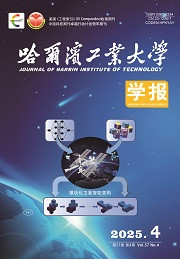| 引用本文: | 谢海鹏,曹云,孔啸宇,朱恒伯,陈旺生,席占稳.MEMS电热驱动器多场耦合模型及温度特性[J].哈尔滨工业大学学报,2025,57(4):142.DOI:10.11918/202405056 |
| XIE Haipeng,CAO Yun,KONG Xiaoyu,ZHU Hengbo,CHEN Wangsheng,XI Zhanwen.Multi-field coupling model and temperature characteristics of MEMS electrothermal actuators[J].Journal of Harbin Institute of Technology,2025,57(4):142.DOI:10.11918/202405056 |
|
| 摘要: |
| 为研究微小尺度下MEMS电热驱动器的温度特性,考虑空气对驱动器动态热平衡的影响,提出了一种基于空气对流传热的电-热-流-固多场耦合模型。根据能量守恒方程以及气体对流换热和热传导等理论,建立MEMS电热驱动器的电-热-流-固多场耦合模型,并进行了有限元仿真。搭建MEMS电热驱动器温度特性试验平台,将恒定电压激励下的驱动器温度响应试验结果与电-热-流-固多场耦合模型以及传统传热模型仿真结果进行对比分析,结果表明:相较于基于恒定对流换热系数及经验公式的模型,采用电-热-流-固多场耦合模型得到的结果准确性更高,稳态温度分布误差在0.8%~7.6%之间;驱动器各表面的对流换热系数分布不均匀;对流换热系数在上表面、下表面及竖直壁面分别呈现先下降后上升、上升以及先上升后下降的趋势,但在3个特征面上对流换热系数几乎同时达到稳态,此时驱动器温度也达到稳态。基于空气对流换热不均匀特性,所获得的电热驱动器温度特性为MEMS电热驱动器在微机电系统中的应用奠定了基础。 |
| 关键词: 电热驱动器 温度特性 对流换热 电-热-流-固 微机电系统(MEMS) |
| DOI:10.11918/202405056 |
| 分类号:TH122 |
| 文献标识码:A |
| 基金项目:国家自然科学基金(52475062) |
|
| Multi-field coupling model and temperature characteristics of MEMS electrothermal actuators |
|
XIE Haipeng,CAO Yun,KONG Xiaoyu,ZHU Hengbo,CHEN Wangsheng,XI Zhanwen
|
|
(School of Mechanical Engineering, Nanjing University of Science and Technology, Nanjing 210094, China)
|
| Abstract: |
| To study the temperature characteristics of MEMS electrothermal actuators at micro-scale, taking into account the influence of air on the dynamic heat balance of the actuator, an electrical-thermal-fluid-solid coupled multi-field model based on air convective heat transfer is proposed. This model is based on the principles of energy conservation along with theories of gas convection and heat conduction. Finite element simulations are conducted to analyze the model. An experimental platform for temperature characterization of MEMS electrothermal actuator is established, and the experimental results of the temperature response of the actuator under constant voltage excitation are compared and analyzed against the simulation results from both the electric-thermal-fluid-solid coupling model and the traditional heat transfer model. The results indicate that compared with the model based on the constant convective heat transfer coefficient and empirical equations, the electric-thermal-fluid-solid coupling model achieves higher accuracy, with the steady-state temperature distribution error ranging between 0.8% and 7.6%. Additionally, the convective heat transfer coefficient varies across different surfaces of the actuator. Specifically it decreases then increases on the upper surface, increases steadily on the lower surface, and increases then decreases on the vertical walls. Despite these variations, the convective heat transfer coefficients on all three characteristic surfaces reach the steady-state almost simultaneously, coinciding with the actuator’s temperature reaching steady state. These findings, based on the uneven characteristics of air convective heat transfer, the obtained temperature characteristics of the electrothermal actuator provide a foundation for the application of MEMS electrothermal actuators in microelectromechanical systems. |
| Key words: electrothermal actuator temperature characterization convective heat transfer electro-thermal-fluid-solid micro-electro-mechanical system (MEMS) |







